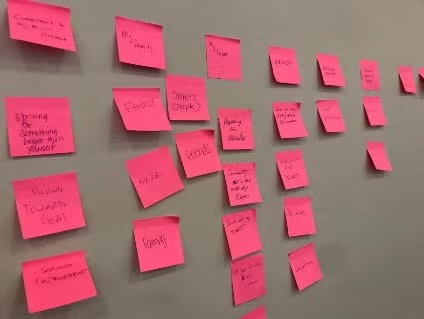By Julia Jones, Head of Training, Thomas International
It’s that time of year when we take stock of how we’ve done over the last year and look forward at what’s to come, pondering over how we could do it better in the coming year. So, what did you achieve? What were you able to tick off?
Did you join the gym? Did you reach your ideal weight? Did you complete the marathon in a record time? Maybe, maybe not. Are you re-calibrating right now and considering how you’ll make this the year that you achieve your goals?
Perhaps even more so than in our personal lives, we set business goals with a great deal more pressure to achieve. Change is constant and agile working practices mean that we improve, refine and deliver constantly. As we find better ways to deliver more, we end up delivering something that wasn’t even a thought process at the beginning of the year. How does this way of working leave you feeling? Accomplished? Motivated? Full of purpose for the coming year? I certainly hope so!
However, for many of us looking back on our work achievements, even if we’ve completed all that we set out to achieve last year, for some reason it just doesn’t feel enough? Does this sound like you? Well, take some comfort in the thought that you are not alone...
Goals introduce a gap between where you are and where you’d like to be. This instantly turns part of where you are right now into a place you really don’t want to be and this is how the very nature of having goals can hurt your self-confidence and self-esteem.
Most people tend to think they need to set themselves goals and objectives to see things happen, but that’s missing the point. Show me a goal-hungry person and I’ll show you someone who’s always wanting something better to come along, someone who’s convinced (perhaps not consciously) that reaching their goals will lead to happiness. Even if the goal is reached, it’s all too likely that it lacks meaning and personal relevance. And once you reach a goal, what’s next?
Self-fulfilment comes from the achievement of life goals which are important to an individual, in contrast to the goals of society, family and other collective obligations.
Within the context of business, targets go up, projects get more complex, the team faces new and different challenges. There’s always a new goal to be achieved giving purpose to our efforts. If we could find a way to link personal goals to work targets and development areas, could we find a better sense of purpose, belonging and achievement?
And if we consider the commercial implications of individuals working towards meaningful goals, what would we see in terms of workplace performance?
- Self-management
- Passion and intuition
- Acceptance of challenge and accountability for success
- Engagement and interest in the business
So, the question for those setting work-based goals is, “How well do you really know your team?”
As a manager, you may feel that you get on well with your team. You know that an individual has hit their target, that they holiday in Corfu and where their children go to university, but the killer question has to be, “Do you know what motivates them?” Do you actually really know?
What if you knew that one of your team was motivated by clarity and communication? They’re unlikely to articulate this unless prompted because it feels a bit soft and fluffy, but having high self-motivation, all they need is a clear idea of what’s required and a sense of purpose to enable them to do their best work. Knowing this, you can adapt your style, providing more time to answer questions, allowing greater access to longer term plans and ensuring that your door is always open for queries.

So, the next questions have to be, “How do we get to understand what really motivates our team and gives them a sense of purpose?” And possibly more importantly, ”How do we get to understand what factors are standing in the way of their success?”
At Thomas we use the following exercise in our training to help fathom this out. We usually allow an hour to complete this activity.
Firstly, using post-it notes, get your team to write down 5 things that really motivate them. I mean REALLY motivate them. Put them onto a wall and take some time to discuss.
You will find that people will have some motivations in common and some that are different. You’ll also find that some see financial goals as a motivator.
Money is only a motivator because it enables people to get the real things that matter in their lives, so quiz those that write this on what they really want that money for.
Secondly, now try the complete opposite! Take a look at the things that stand in the way of your success.
Ask your team to note down the five things that really annoy them and prevent them from achieving success. Interestingly, you’ll find that these obstacles are external factors that can’t easily be changed by the individual, but there may be things that you as a boss or a business can do to mitigate or overcome these roadblocks.
While it’s good to identify obstacles to success, once everyone understands that these things can’t be changed, it becomes easier to see that an individual’s focus should be on what makes them happiest and most fulfilled, rather than wasting their time and emotional energy.
So now you know what motivates your team and what they see as the obstacles to their achievement. The next step is to set meaningful goals that resonate with each individual’s personal values and motivators, something we can find out using the Thomas assessments.
The individual with the workplace personality (HPTI) score card below has moderate levels of conscientiousness, which could mean that they find it quite hard to maintain focus on their goals and need nudging to deliver. Contrast that with someone with high levels of conscientiousness, who could spend a lot of time planning and be perceived as procrastinating.
As a boss, the individual with high conscientiousness may set too many goals and be constantly disappointed that they weren’t being met.
The ability to identify strengths and limitations helps inform us as to our behaviour and allows conversations to take place that enable alignment of expectations and the development of strategies to promote harmony and cohesion.
Coupled with insight from the Thomas Emotional Intelligence (TEIQue) assessment, we can also determine if goals need to be linked to external results and rewards or internal motivations such as self-fulfilment, personal achievement or recognition.
So, looking at the chart below for example, this individual has high adaptability, which may sound very positive, meaning that they are good with change. However, this also means that it’s important for them to set and regularly review their goals to ensure they deliver. This high adaptability can mean that the individual can be easily distracted by the next bright and sparkly thing to come along and that they find it difficult to finish a project.
If you want to create goals that will be effective at motivating you or your team, you need to make sure that:




